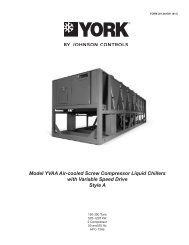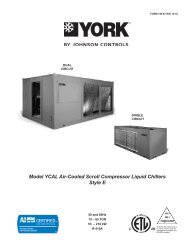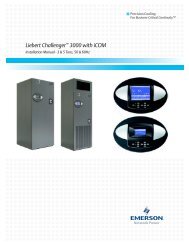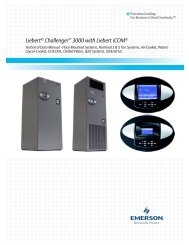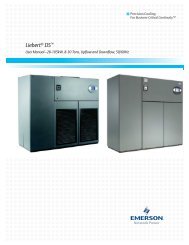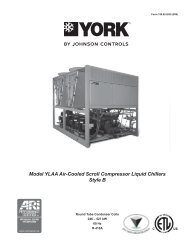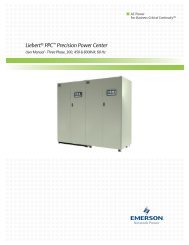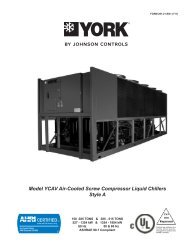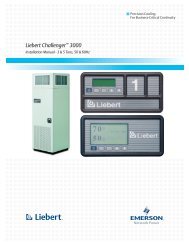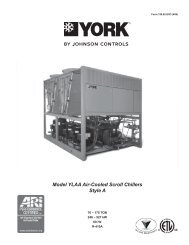Liebert Challenger 3000
Liebert Challenger™ 3000 Operation & Maintenance Manual - DCES
Liebert Challenger™ 3000 Operation & Maintenance Manual - DCES
Create successful ePaper yourself
Turn your PDF publications into a flip-book with our unique Google optimized e-Paper software.
Operation with Advanced Microprocessor ControlsSelect Control Type• Intelligent (Chilled Water only)• Proportional (all unit types)• Tunable PID (Chilled Water or SCR Reheats only)The type of system control method used by the microprocessor can be selected from the front panel.The default setting is Intelligent, which approximates the actions that a human operator would taketo maintain precise, stable control. The control logic uses Artificial Intelligence techniques including“fuzzy logic” and “expert systems” methods to maintain precise, stable control and increase reliabilityby reducing component cycles. Proportional is a standard control method that uses one gain factor(temperature sensitivity adjustment). Tunable PID (Proportional, Integral, and Derivative) usesthree gain factors selected by the operator. PID allows precision tuning, but requires an experiencedoperator and seasonal adjustments. Note that if PID is selected, it is used for temperature controlwhile humidity will continue to use Proportional control. Refer to 4.0 - System Performance withAdvanced Microprocessor Controls for more detail on types of controls.Setup AlarmsSelecting SETUP ALARMS will step to the following menu:•SET TIME DELAYS• ENABLE ALARMS• ENABLE COMMON ALARM• SET CUSTOM ALARMSEach individual alarm can be programmed with a time delay from 0 to 255 seconds. Each individualalarm can be ENABLED or DISABLED and each individual alarm can be programmed to energize ornot to energize the Common Alarm Relay.Set Time Delays—By programming a time delay for an alarm, the system will delay the specifiedamount of time before recognizing the alarm. The alarm condition must be present for the amount oftime programmed for that alarm before it will be annunciated. If the alarm condition goes awaybefore the time delay has timed out, the alarm will not be recognized and the time delay timer will bereset. For software alarms such as Loss of Power, Short Cycle, and Low Suction Pressure, a timedelay will only delay the annunciation of that alarm. The condition of the alarm is not applicablebecause the condition has already occurred. For these alarms the time delay should be left at the factorydefault of 0. Table 5, below, shows the default time delays for each alarm.Table 5 Alarm default time delaysDefault TimeAlarmDelay (seconds)Humidifier Problem 2High Head Pressure 2Change Filter 2Loss of Air flow 3Custom Alarm #1 0Custom Alarm #2 0Custom Alarm #3 0Custom Alarm #4 6High Temperature 30Low Temperature 30High Humidity 30Low Humidity 30Low Suction Pressure 0Short Cycle 0Compressor Overload 2Main Fan Overload 5Loss of Power 09



